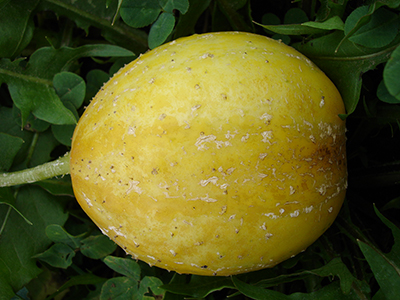Cucumis sativus L. (Cucurbitaceae) cv. Lemon


| ENG | Cucumber |
| SK | Uhorka siata |
| CZ | Okurka seta |
| PL | Ogorek |
| HU |
Using
Unripe cucumber fruits are eaten raw in salads or pickled in brine with various spices. Central Europe specialty are lacto-fermented cucumber pickles. Naturally occurred cultures of bacteria transform the fruits into pickles by converting sugars to lactic acid, acetic acid, carbon dioxide, and other beneficial substances. The lactic acid is responsible for preserving the vegetables, as well as creating the wonderful flavor and aroma of lacto-fermented pickles. Cucumber fruit is very high in water content and very low in calories. It has potential antidiabetic, lipid lowering, antioxidant activity. The fruit is refrigerant, haemostatic, tonic and useful in hyperdipsia, thermoplegia etc. Fresh fruit juice is used for nourishing, soothing against skin irritations and reducing swelling and alleviating the sunburn's pain. The seeds are used to prevent constipation.
| I. | II. | III. | IV. | V. | VI. | VII. | VIII. | IX. | X. | XI. | XII. | |||||||||||||
| Sowing (greenhouse) | ||||||||||||||||||||||||
| Sowing (field) | ||||||||||||||||||||||||
| Planting | ||||||||||||||||||||||||
| Harvest | ||||||||||||||||||||||||
Botanical description and occurrence:
The cucumber is originated to India. It is a annual, monoecious, creeping vine with large leaves, yellow flowers and cylindrical, elongated fruits which may reach 60 cm of length. Fruits - Pepo berries - are culinary used as vegetables in unripe stage. ‘Lemon’ may be the oldest cucumber cultivar now being grown, originated in the late 19th century. ‘Lemon’ is an early cucumber, with round, yellow fruits suitable for salads and pickling. It is typical cultivar for amateurs and has no real commercial importance because of low yielding, and small disease resistance.
Why to have the plant in your garden:
‘Lemon‘ is unusual decorative salad cucumber. Plants grow up trellises, wrapping around supports with thin, spiraling tendrils. Fruit looks similar to a lemon with a thin, yellow rind. It is considered to have a better flavour than conventional cucumbers, being non bitter, very sweet and slightly flavoured with lemon. Paring is unnecessary because the rind is thin and lacks all trace of bitterness. Imagine a cold, summer drink with the slice of yellow cucumber...
Text:
Dr. Agnieszka Sekara, University of Agriculture in Krakow, Poland
Photo:
Dr. Agnieszka Sekara, University of Agriculture in Krakow, Poland

